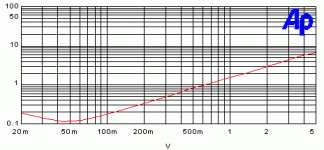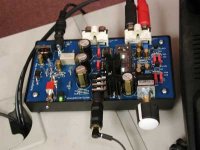BTW, is the input stage before the 6p1 really necessary?
The input impedance is not that high, what with the bias circuit and all.
Input buffer not required if you have a low impedance source.
Now, would this one count more as a buffer or a preamp.
My copy has about 16 dB gain. I didn't want that much, but that's where I
decided the distortion vs amplitude characteristic was optimal.
I assumed that it doesn't have enough gain (I thought 10 db at most) or that it can't swing enough voltage to drive a mosfet follower (like F4).
You would want to look at the distortion curve and decide for yourself.
My take on it is that you don't probably want more than 1% thd, which keeps
you in the "sub 1 volt" output region.
I think it could do without either buffer, but in that case it means that one will have to know exactly where it can work, (if you have a previous stage with low output impedance and the following stage-amp with the high input impedance). But, if you produce it as a standalone unit, you don't always know where or how the user will put it, so..
What I like to see is some sort of Pass hybrid, where this tube will provide voltage gain. The rest is a common FW stuff 🙂. Jfets at the input, mosfets at the output. Let's call it "the J-tube" 😀
What I like to see is some sort of Pass hybrid, where this tube will provide voltage gain. The rest is a common FW stuff 🙂. Jfets at the input, mosfets at the output. Let's call it "the J-tube" 😀
...you don't probably want more than 1% thd, which keeps
you in the "sub 1 volt" output region.
Maybe I got it wrong, but does it mean that its distortion would be too high if it was requested to swing high voltsges, as required for a mosfet follower?
Some people made plexiglass boxes (laser cut or 3D printing ?)
but frankly, who knock the glass or shake his preamp in everyday listening.
Just touching the volume control on mine (not a stepped control) gets me the fairy dust sound that ChuckT mentioned. That would create a reasonable possibility that typing on the keyboard a foot away is introducing noise into the audio too.
Would it be sacrilegious to put 10dB of feedback on it?Depends on what you mean by "too high".
For those that didn't read the pdf, here's the curve.
Would increasing power supply to 30V bring distortion down?
Looks like the distortion has been designed for an amp with at least 20dB of gain.
Last edited:
Two replies,
If touching the volume control gets a reaction you want to check to see
that the case of the volume control, and maybe the faceplate is grounded.
This is a common problem.
And no, there is nothing sacred about feedback / no feedback, as 2 pico
well knows.....
If touching the volume control gets a reaction you want to check to see
that the case of the volume control, and maybe the faceplate is grounded.
This is a common problem.
And no, there is nothing sacred about feedback / no feedback, as 2 pico
well knows.....
Health warning: this circuit may be unsuitable for people suffering from cap-neurosis 😎
A cap here, a cap there, caps everywhere :buehehe: Such is life, one has to choose. Active components or passive, no way around. Well, then, let's build an expensive preamp, with silver wiring, Jupiter capacitors, golden or wooden case with anti-resonance-ultra performing shock absorbers. Battery supply. That, driving a thousand J-fets amp, connected to a SAL fullrange driver in a J-lo horn. Heck, why not? 😀
Last edited:
Oh, just done some reading....somebody had the same dream as I did:
http://www.diyaudio.com/forums/pass-labs/313649-build-mofo-4.html#post5217741
At BAF, Nu Toob meets MoFo. SAL will help, too 😉
http://www.diyaudio.com/forums/pass-labs/313649-build-mofo-4.html#post5217741
At BAF, Nu Toob meets MoFo. SAL will help, too 😉
Maybe we can buy DIY pcb's version with Korg Nutube in DiyAudio Store in near future ?
+1🙂
Are there any JFETS that handle high voltage and could be used with more conventional tubes in the same circuit?
If touching the volume control gets a reaction you want to check to see
that the case of the volume control, and maybe the faceplate is grounded.
This is a common problem.
I have a plastic knob on the volume control. I'll have to see if I have any way to shoot a video of it in action with good audio but I can pretty much play a song with different ringing sounds by tapping or brushing anywhere on the plastic case, pcb, components or cords plugged into it. If I really upset it the ringing takes about 1-2 seconds to fully fade from my ability to hear it.
Maybe I have an odd one that likes to sing. I need to experiment with my buffer one and see if it does the same. Although I keep thinking I may disassemble it and my recently completed B1 to make the B1 with Korg 😀
Attachments
Last edited:
Thank you for another fun project!!!! 🙂
+1
Originally Posted by Soundhappy
Maybe we can buy DIY pcb's version with Korg Nutube in DiyAudio Store in near future ?
+1
Last edited:
Are there any JFETS that handle high voltage and could be used with more conventional tubes in the same circuit?
Easy to obtain current production, UJN1208K, sort of burly for a preamp. As for other options that may be nearing unobtanium, I won't be of much help there, my knowledge is stunted 😛. I know it's no longer exactly the same design, but it's for a follower, plenty of MOSFET options.
- Home
- Amplifiers
- Pass Labs
- B1 with Korg Triode



